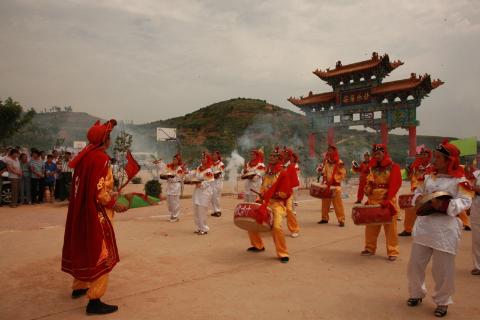Through a joint development effort of poverty-struck Shangwa Village by Mercy Relief and its local partners, it has transformed from a cluster of cave-home dwellings to a self-sustaining eco-village, such that it has been touted as a model village of Yuanqu.
The Singapore-born NGO held an inauguration earlier today at Shangwa Village to celebrate the successful implementation of its development initiative; the event was graced by Mercy Relief’s Chairman, Mr T K Udairam, andofficials from Shanxi Poverty Alleviation Bureau.
Shangwa village bearing a boisterous spirit in a new environment.
A bird’s eye view of the new Shangwa Village.
Characterised by mountainous terrain where farming conditions, soil quality and accessibility to the markets are low, Shangwa is the most impoverished village in Yuanqu County –with annual average per capita income for the mostly-farming population standing at 800 yuan. The villagers carve holes out of caves and call them home, even as they have been dilapidated through the years.
The Old juxtaposed with the new
Recognising the need for self-sustenance by the villagers, Mercy Relief proposed to its partner SPAB the installation of a biogas digestor system in 2008, together with the provision of 352 piglets for all 88 households for pig-rearing. This initiative facilitated the harvesting of renewable energy through the fermentation of human and animal excreta in the digestors, which are used to power up biogas cookers and lamps, generating savings from having to use coal for cooking and buying electricity from the grid; and at the same time allowing the villagers to sell pigs for more income. The residue from the digestors is recycled as crop fertiliser, generating even more savings.
The new homes in Shangwa come with biogas digestors at their doorsteps.
Invigorated by this initiative, Changzhi Township government got into the act, deciding to relocate the village altogether. Being nearer to the county centre would increase accessibility to the markets, healthcare and education facilities, as well as more farmland.
The collaboration opened up more development manoeuvres by Mercy Relief –other than its biogas digestor system, it also paved 5.2km2 of roads within the new village to improve accessibility and built 2km of perimeter walls. Its efforts came up to S$320,000. Together with Changzhi Township government’s efforts in primary village infrastructure which cost S$1.2 million, a new village was born in June 2009.
Mr TK Udairam commented that “the catalyst effect was a prominent feature of this project, and is an excellent example of the impact of a positive collaboration between Mercy Relief and its partners.”
This project underlines Mercy Relief’s holistic approach to addressing shelter and livelihood issues as part of its sustainable development efforts in China.
About Mercy Relief
Mercy Relief is a Singaporean humanitarian organisation which engages in both disaster relief and sustainable development programmes. It was established in 2003 as an independent non-governmental humanitarian charity responding to the human tragedies in Asia. Mercy Relief’s aid programme focuses on providing timely and effective assistance to disaster-stricken communities and has maintained the delivery of emergency aid within 72 hours from the point of appeal for assistance.
In the past 12 years, Mercy Relief has disbursed over S$32 million in aid across 40 disaster relief and 53 sustainable development initiatives. Mercy Relief has impacted an aggregate of 2 million lives in 24 countries and areas, namely Afghanistan, Bangladesh, Cambodia, China, DPR Korea, India, Indonesia, Iran, Iraq, Japan, Laos, Lebanon, Malaysia, the Maldives, Myanmar, Nepal, Pakistan, Palestine, the Philippines, Sri Lanka, Taiwan, Thailand, Vietnam and Yemen.
For more information, you may call us at 6514 6322 or email corporateaffairs@mercyrelief.org







